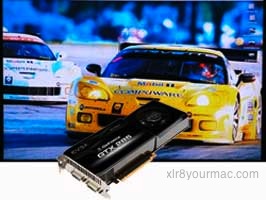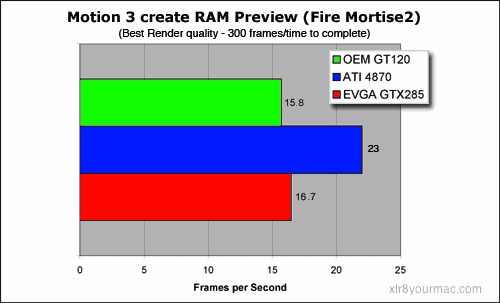With the GTX 285 usually in a lower power mode (in other than 3D games), it's at a disadvantage against its main Mac (retail) competitor - the ATI 4870. As I mentioned back in March, ATI's Overdrive (in Windows) reported idle speeds of 600Mhz core/850MHz Memory - i.e. only a downclock of 150MHz on the core with the Mac 4870. (I saw much lower idle clocks on an XFX 4890/1GB (850MHz GPU) card in a real PC - 240MHz at idle.)
First of all, I completely understand the trade-off from the mfr's point of view (a LOUD card sold into the Mac Pro market -regardless of performance- would have been a show-stopper sales wise in my opinion). But personally I wish they'd offer a utility for OS X that would allow the user to adjust modes/clock speeds - even if it wasn't as complete as their Precision Utility for Windows.
FYI - Here's some comment from Nvidia in a post in their CUDA forums regarding the GTX 285's agressive power savings in OS X (currently) from a user and a reply from Nvidia:
This test doesn't tax the graphics card (or overall system) nearly as much as the 3D gaming tests. (As noted on the intro page's observed System power usage results, total system wattage during Motion 3 tests were about half that of 3D gaming and lower than the 4870 card. Although I have no OS X monitoring utils, I think it's clear the GTX 285's clock speeds were running at less than max mode during this test - as with most non-3D gaming tests.)
For what it's worth, exports with the 4870 installed were a bit faster (appx 7%, not major).
This system has Final Cut Studio 2 (fully updated) installed and I'm making plans to take the system to a local Video production house and have their FCP editor give me his opinions on performance in those Pro apps of the GTX 285 vs ATI 4870. (As last year some FCP users commented they switched from 8800GTs to ATI 3870s for better core video performance, although that was a couple OS X updates ago, but ATI has a rep for better OS X core image performance.) [FYI - On June 23rd Apple released Final Cut Pro 6.0.6 which they say "fixes problems with real-time playback in Final Cut Pro with Mac Pro (Early 2009) models and Xserve (Early 2009) models"]
When I get the free time, I'll also give Aperture 2 a try (after dropping $700 on the FCS2 upgrade, it'll be the Trial version though). [BTW - not really any significant differences from what I've seen so far with the trial - certainly not a reason to switch cards for that app use alone.]
OEM GT120: 47 sec
I didn't bother to graph results of other simple apps tests like Scrolling through my appx 1800 image library (thumbnail view) in iPhoto 09, as all 3 cards showed literally the same performance. (Within less than 1/2 second difference - well within the margin of error for stopwatch use.)
And as mentioned above, the 285 doesn't seem to fully clock up for light-duty apps like that . I guess I'm impressed it does as well against the 4870 in those cases as it. I personally am satisfied overall with the 285 - but my usage/needs may not be the same as yours.)
QT and DVD Playback: Playback of that HD video (full screen) looked great on all 3 cards and all had no performance or image issues seen. I used to include notes on CPU usage during DVD movie playback in older reviews, but with current systems that's almost trivial. (I did playback a DVD movie (Bourne Supremacy) - it had very very low CPU usage.)
Looking for feedback from Maya (or other Pro 3D Apps) users with GTX 285 card:
(Update/FYI: Two GTX-285/Maya 2009 users reported viewport, etc. problems are solved in OS X 10.6.2.)
I recd an email/FYI on problems seen in Maya 2009 with the Mac GTX 285 (still no reply to questions if the 2F16 driver update was used - mail was from a gmail acct w/no name, perhaps a 'spam acct') and wondering if any other readers are running Maya (or other Pro 3D app) with the GTX 285. Here's a clip from that mail:
"Subject: FYI on Mac Pro GTX 285 (OS X 10.5.x)
If you are going to doing any 3D work outside of Cinema 4D and Poser, do not get this card. Maya 2009 performance is horrible, artifacting within windows, worse than the ATI 2600 that came with the machine by default. (2008 Mac Pro I assume,-Mike) Backculling is terrible as well. Marquee selection creates artifacts and numbers will disappear upon scrolling within windows.
Video performance within FCP is very good, no dropped frames visible. Photoshop performance is good as well."
If you're using a Pro 3D app with a Mac GTX 285 card (or a Quadro FX 4800) in OS X, let me know if you've seen similar problems. (I'm looking for reports from people actually using 3D apps for projects/work. These sorts of issues are not picked up in typical OS X benchmarks)
Update (7/14/2009) - here's another reply:
(OS X 10.5.x)
"I bought the GTX 285 card to replace the GT120 which was worse than awful with Maya (2008, 2009 SP1a). I've been using it for about 3 weeks for a variety of scenes, mostly modeling, I don't do that much animation.
With a reasonably big scene (200,000 or so polys), navigation is great in wireframe, OK shaded and unusable if you throw everything at it (high quality rendering and hardware texturing). When I say useless, mean that the scene jumps around as you navigate in a completely unpredictable way and any fine degree of control is impossible.
I'm going to try some experiments with running Maya under bootcamp on the same machine to see if this is a Mac problem, or if I'm just expecting too much. I've logged a support case with EVGA, but they don't seem that interested.
No experience of the 4800. I guess that it should be better, but from the Mac forums posts, what I'm reading is that it's got the same driver problems as the 285, so the extra cash isn't going to help.
Cheers - ian"
I never had a FX4800 but thought they used the same OS X driver. (As of summer 2009 the latest GTX 285 OS X driver is 18.5.2f16 (installer dated June 10th) although nvidia's Quadro 18.5.2f16 driver page says it's specific to the FX4800 and has a 'release date' of June 26th, it appears to be the same installer (dated june 10th), but I've not dug thru the entire pkg.) Historically the windows drivers for quadro cards are better optimized. That's always been said as "one of the reasons you pay more for Pro 3D cards". (Some problems can be due to the App's code (or the OS GL frameworks) and not the driver, although it gets the blame usually.)
FYI/Tips for EyeTV 3:
I don't have EyeTV installed on the test Mac Pro, but a reader that does noted he had problems after the GTX 285/driver install which was later fixed he said after ElGato provided him with a (unreleased to date) beta (5238) build of EyeTV 3.1.2 (The public release of 3.1.2 is 5235.) If you have EyeTV 3 installed, you can get the 5238 build by entering this in your browser:
eyetv://checkforupdates?build=5238
The latest build as of July 31, 2009 is 5242. (Over time some builds may no longer be available.) EyeTV 3 will then launch and get the updated build. (Thanks to Darius for the tip.)
3D Game Tests:
Typically 3D games are (by far) the highest stress test (and performance delta) for graphics cards. (I only have a 24in display, so the max res I can test is 1920x1200.) Here's some results from a few games that I had installed.
Quake 4 (1.4.2):
It'd been awhile since I played Q4 (and never at this high a rez before) - the model detail at 1920x1080 HQ was impressive IMHO. With 1GB of VRAM, the GTX 285 can use "Ultra" quality in Quake 4. (ID warns that mode uses more than 500MB of textures.)
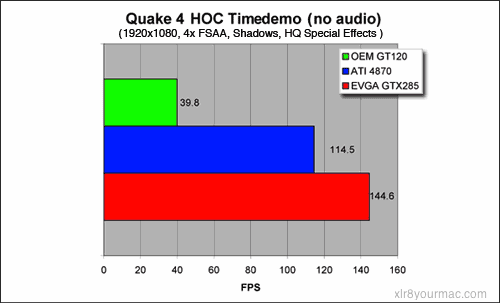
(Update: - Late Tuesday night after about 30 minutes or so of Quake 4 in Ultra mode (1600x900, no AA), the game unexpectedly quit (black screen, then the Finder). System didn't lock up and the desktop/display wasn't corrupted (as usually seen if overheating). I saved the log. Started it up again (2 min later) and within 5 min, another quit [seg fault]. This one was trapped normally however, with the dialog/"send report to Apple" option (done). Saved that log was well.)
FYI: The F16 driver update didn't change framerates for this timedemo. (But not yet tested Ultra Mode since the F16 driver update.)
Prey:
I'm told Prey for the Mac isn't multi-threaded (as it is on the PC) but here are the results using HOC's demo file.
(Updated for F16 driver tests, which significantly boosted FPS in this timedemo.)
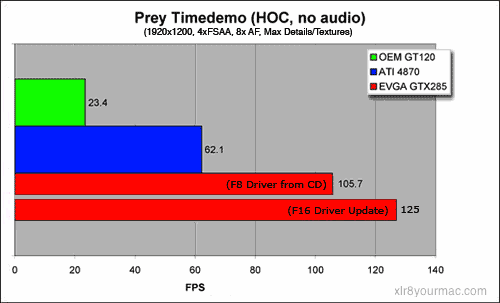
Halo (v2.0.3):
Halo tests were done with the Universal Binary version w/2.0.3 update applied. (Although particles were enabled, the results file still shows them off but that's been true since day one.)
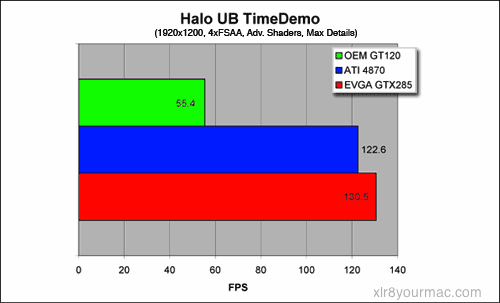
FYI: The F16 driver update didn't change framerates for this benchmark.
Call of Duty 4 MP Timedemo: v1.7.1, latest as of June 2009. (Graph updated for GTX 285 results with F16 drivers.)
At up to 1920x1200 at least, it still looks like ATI rules in OS X Call of Duty 4 (my favorite FPS game to date). The 4870 just delivered better framerates on this system with a 24in (1920x1200) display. I had hoped the GTX 285 would have twice the performance it did on this benchmark in OS X. (And actual gameplay in OS X at 1920x1200 w/HQ settings (even w/o FSAA) wasn't anywhere near as smooth as Windows w/same settings - In Act 1 "War Pig" firefights even w/o FSAA at 19x12 HQ showed framerates dropped enough to affect survival. In Windows (directX), COD4 performance w/GTX 285 was excellent - in actual play usually 70-100+ FPS even at 1920x1200/4x FSAA, HQ - smooth as butter).
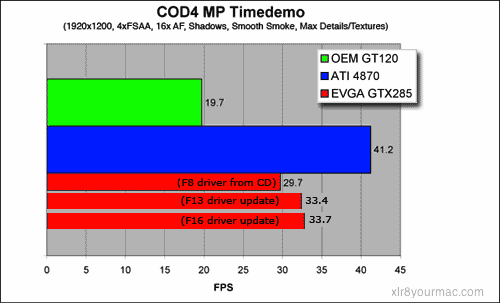
I don't have a 30in LCD display to see how much drop that extreme resolution have on the lesser (GPU/Vram) cards but 2560x1600 with FSAA should take a big toll on them. But I suspect the ratio of 24in (or less) vs 30in display owners is at least 30 to 1.
But IIRC, Mac COD4 was one game where the ATI 3870 outperformed the 8800GT (which was faster in many others), so I assume the ATI drivers are just better optimized for this game. Of course I could force an impact on the ATI card by running it at extreme resolutions, but don't have a display with higher than 1920x1200 res.
I also tried a reinstall of the game/reapply of the v1.7.1 patch just to see if that improved nvidia scores - it didn't. Perhaps an update to Mac COD4 would show better results with the GTX 285 card, but not sure that will ever happen.
FYI on WoW: I don't play World of Warcraft, but I had a 2008 Mac Pro w/8800GT card owner report he's only seen about 5fps gain with the GTX 285, and a 4870 owner saying he didn't notice any improvement - both using a 24in Display (1920x1200). (I don't know if that's typical as there's a lot of variables possible.)
FYI on The Sims 3 Problems for OS X (10.5.x): GTX 285 owners have reported problems running Sims 3 for OS X (hangs/freezes) - apparently an issue with the drivers (2F16 is latest currently) and this game as reverting back to an 8800GT card didn't help a reader said - although a Time Machine backup restore of the nvidia extensions from the TM backup's System/Library/Extensions worked w/8800GT card. (No problems reported running Sims 3 for Windows with this card)
Initial reports on the problem were before the (June 25th) Sims 3 v1.2.7 patch but a reader said that did not help (he updated to 1.2.7.2 before getting the GTX 285 card). The only Mac specific change listed was "This update deals with some issues on Mac systems that can crash the game while connecting to AFP servers".
Update (Sims 3 v1.3 patch: On July 27th The Sims 3 v1.3 patch was released with several "mac only" fixes/improvements (including graphics), but per this report, it doesn't fix the GTX 285 problem:
"Mike, the 1.3.24.2 Sims 3 patch does improve the graphics. But at a fairly high cost of fps (still needs optimization). Unfortunately this hefty patch does not address the eVGA GTX285 driver problems and the game still will not load with this patch if the GTX285 driver is installed.
Still, a lot has been done with Cider to address what has been major public outrage at the disparity between the look and feel of the Mac and Windows game play environments. Mac users now have anti-aliasing and lighting effects...But...
With the nVidia GeForce 8800 GT the game (pre 1.3 patch) was averaging 40fps, now (v1.3.24.2) it dips to the low 20's. (1920x1080 res.) To compare, the GTX285/Vista 64-Bit BootCamp combo runs on my MacPro at around 95 fps constantly and goes to 120fps in places.
Regards, Neal"
FYI on OS X 10.6.0: (8/28/2009) Neil was the 2nd GTX-285/Sims 3 user to report OS X 10.6.0 seems to have solved this. Here's his follow-up mail on 8/31/2009 regarding performance in 10.6.0:
"Sims III/GTX-285 in OS X 10.6.0
I managed to squeeze in an hour of The Sims 3 last night and must report that the performance of the game running under 10.6 with an EVGA GTX285 is atrocious.
In fact the fps differ marginally from those I was achieving with 10.5.7 and a GT8800 in my MacPro.
To activate the fps display in The Sims 3 one needs to press and hold Control-Shift-c this brings up the cheat console into which one types fps on (carriage return). This puts a small display of fps in the top right corner of the game screen.
I tested the GTX285 in Bootcamp with Vista (SP2) using the latest Windows nVidia drivers (190.62 released 8/21/2009.-Mike) and in Snow Leopard with 10.6.0 supplied drivers.
All graphics features were set to max and display resolution was 1920x1200
I needn't give more than a few figures as the results speak volumes.
I went to three locations using the exact same gamesave in both the Vista and OS X Snow Leopard.
Sims household with three active Sims:
Vista averaged 70-88 fps whilst observing the household activities
Snow Leopard achieved a max fps of 44 but stayed in the 20's most of the time.
Park view with several active Sims:
Vista averaged 72-90 fps
Snow leopard managed 45 fps max but again held at the mid 20's.
Coast line (one Sim fishing)
Vista hit 270 fps
Snow Leopard 105 fps
As I mentioned earlier the Mac OS X 10.6.0/GTX 285 performances are near identical to the nVidia GT8800 10.5.7 rig. So a $450.00 GTX285 adds approximately nothing to this gaming experience. How much of a performance hit is a result of Cider running The Sims 3 or the nVidia drivers built into 10.6.0 is unknown.
Regards, Neal"
I'm really not surprised at the lower OS X game FPS scores although I'm sure Cider just makes it worse. Historically game FPS has been higher in Windows vs OS X on the same hardware (I saw the same thing with COD4 w/10.5.x vs Vista) and others noted it with Doom III, X-Plane, etc.) OS X 10.6.x/driver updates may improve performance (and fix bugs), but Nvidia and ATI are very aggressive/proactive on driver updates for Windows.
And GTX 285, 8800GT and 8600M (MacBook Pro) 10.6.0 users have also reported no AA options in World of Warcraft with OS X 10.6. Several GTX 285 owners have said WoW objects had 'outlines' around them in 10.6.0. But as usual I didn't expect any "dot zero" OS release to not have some problems, bugs, etc. (Some (not all) ATI 48xx/10.6.0 WoW users also reported problems.)

